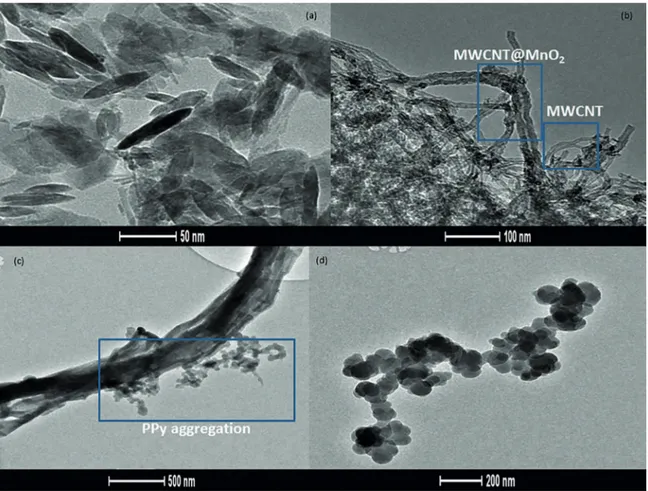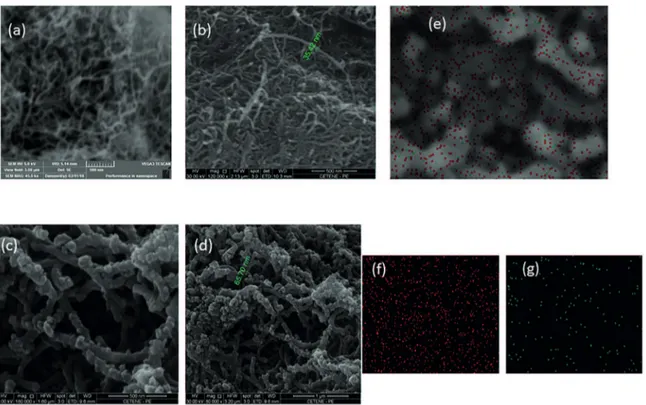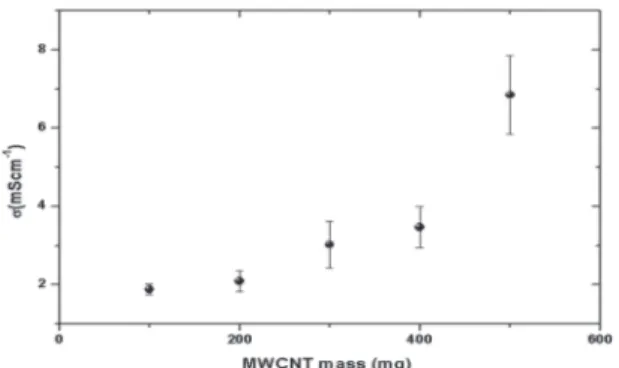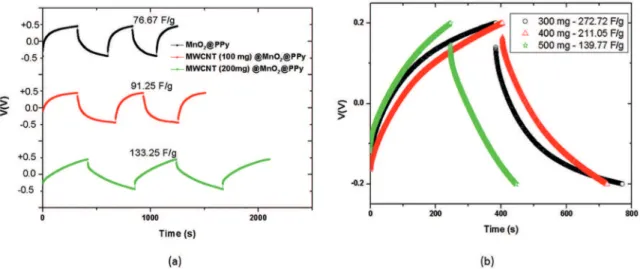Carbon Nanotube@MnO
2@Polypyrrole Composites: Chemical Synthesis, Characterization
and Application in Supercapacitors
Ariadne Helena Pequeno de Oliveiraa,b, Marcio Luis Ferreira Nascimentob, Helinando Pequeno de Oliveiraa*
Received: May 3, 2016; Accepted: July 25, 2016
Core/shell structures of carbon-based materials/ metal oxide have been considered as potential candidates for electrochemical devices due to their improved pseudocapacitance/electrical double layer capacitance and high conductivity/ superior surface area. The development of multiple core-shell structures of MWCNT@MnO2@PPy was analyzed as a standard procedure for mass production of supercapacitor electrodes. The relative concentration of carbon nanotubes in the composite was varied to optimize the double layer capacitance contribution in overall response of device. Resulting structures presented capacitance in order of 272.7 Fg-1 and reasonable cycling performance.
Keywords: advanced energy systems, carbon nanotubes, smart materials
* e-mail: helinando.oliveira@univasf.edu.br
1. Introduction
Owing to the increasing demand for more eicient energy
source and storage devices in our daily life (such as portable electronics and hybrid vehicles), increasing attention has
been dedicated to producing energy storage lexible devices
with improved cycle life- and charging/ discharging- rate. The development of new electrochemical energy-related systems based on lithium-ion batteries (LIBs),1,2 microbial fuel cells (MFCs)3 and supercapacitors requires the production of sustainable electrode materials with high energy density, high power density, good cycling performance in association with simple and low cost processability, due to the successive insertion/ exclusion of ions during successive cycles. The use of polymeric structures with a stable skeleton and large conjugated structure represents an important strategy to preserve charge transfer mechanisms.1,2
Supercapacitors, also called electrochemical capacitors, present higher power- and energy- density.4-6
Typical supercapacitors (standard symmetrical assembly) are composed by two electrodes separated by a solid membrane. The energy storage is due to the formation of double layer and redox reactions in carbon derivatives and conducting polymer/ metal oxide, respectively.7-11
Non-Faradaic process dominates in the EDLC response
and depends on speciic surface area/ porosity of
carbon-based materials.12-14 Carbon derivatives (such as carbon
nanotubes, reduced graphene oxide – rGO and modiied
graphene – Claisen Graphene)15-19 have been considered as potential candidates for EDLC devices. Particularly, the chemical stability, strong mechanical resistance, superior electric conductivity, transparency in visible/ near infrared
region and lexibility play a pivotal role for application of
carbon nanotubes in new types of electronic devices such as
lexible devices,20 transparent electrode for dye-sensitized solar cell,21-23 anode for microbial fuel cell 24 and so on.
On the other side, pseudocapacitors (conducting polymers and metal oxide nanoparticles) contribute to charge storage mechanisms due to their characteristic fast redox reaction (Faradaic process). Conducting polymers (such as polypyrrole - PPy) introduce important advantages relative to environmental stability, high conductivity, high chemical stability and processability.4,12,25-27 In addition, the chemical synthesis of free-standing polypyrrole nanotubes provides a potential candidate for thermoelectric application28 and membrane for anode of microbial fuel cells.29
Based on these aspects, it has been reported the use of carbon-based materials in association with pseudocapacitors to achieve the desired performance for energy storage devices.30-33
In terms of pseudocapacitance, MnO2 presents an
extraordinary theoretical speciic capacitance of 1370
F/g,31,34 which is associated with poor electrical properties (low conductivity).
To circumvent this limitation, the combination with
conducting polymers ofers an interesting alternative directed
to the production of hybrid conducting polymer/ metal oxide composite with improved electrical/ electrochemical properties.31,35
The speciic capacitance of polypyrrole nanotubes
(reported by de Oliveira and de Oliveira)15 is in order of
47.83 F/g. The association of polypyrrole with modiied
graphene oxide returns capacitance in order of 277.8 F/g 17 while association of GO and PPy provides capacitance in order of 289 F/g.25 The association of MnO
2 and graphene results in a capacitance of 192 F/g 19 while composites of MnO2/GNS/CNTs returns a value in order of 132 F/g.19
a Institute of Materials Science, Federal University of Sao Francisco Valley – UNIVASF, 48902-300,
Juazeiro, BA, Brazil
b Department of Chemical Engineering, Polytechnic School, Federal University of Bahia – UFBA,
The synthesis of polypyrrole on MnO2 surface results in a porous composite with increasing surface area and reduced deterioration degree of PPy during charging/ discharging process.34,36 The incorporation of carbon nanotubes improves the electrochemical- and mechanical- response of resulting
highly lexible electrodes.31
Wang et al.37 reported the production of MnO 2/PPy nanosheets (by chemical polymerization on carbon cloth) for symmetric supercapacitors. The combination of Li4Ti5O12 nanowire with MWCNTs deposited on carbon cloth and copper-nickel oxide nanostructures38 represent other interesting strategy in the direction to develop 3-d arrays with superior volumetric energy storage capabilitiy.39 Li et al.40 reported the combination of ferroferric oxide-carbon (Fe3O4-C) nanorod array as a convenient strategy for improvement in cyclability of electrodes. Alternatively, anodes based on core-shell structures such as TiO2-MnO241circumvents the typical low cyclability of individual components. As we can see, the association of components (carbon nanotubes, polypyrrole and MnO2) in hierarchical structures favors
important applications due to the ion difusion distance and
available surface area for ionic reaction.
In this work, we have chemically synthesized dual core-shell organic-inorganic devices for application as supercapacitor electrodes. Corresponding systems (reported in the literature)42,43 were typically synthesized by electropolymerization. The relative concentration of carbon nanotubes in composites was varied in order to establish the best ratio of EDLC/ pseudocapacitance in hierarchical structures.
2. Experimental Procedure
Multi-walled carbon nanotubes (MWCNT), KMnO4, MnSO4, ammonium persulfate (APS), HCl and KCl were of analytical grade, produced by Aldrich and used as received, while pyrrole (Aldrich) was distilled before polymerization. Dual core-shell coaxial composites were prepared according a two-step procedure: the synthesis of MWCNT@MnO2 complex and the preparation of coaxial MWCNT@MnO2@PPy.
2.1. Synthesis of MnO
2nanorods (α-MnO
2)
Nanorods of MnO2 were synthesized according procedure reported by Sen et al.:44 KMnO
4 aqueous solution (0.1M in 10 mL) was mixed with an aqueous solution of MnSO4 (0.15 M in 10 mL) and vigorously stirred for 6 hours. The resulting dark-brown precipitate was separated by centrifugation and dried at 100 °C.
2.2. Synthesis of composite MWCNT@MnO
2MWCNT@MnO2 composite was synthesized according procedure reported by Li et al.:30 KMnO
4 (100 mg) was dispersed in milli-Q water (50 mL) at 80°C with variable
amount of MWCNT viz. 0 mg, 100 mg, 200 mg, 300 mg,
400 mg and 500 mg. Resulting solution was acidiied with
aliquots of HCl (2 M) until reaches pH 3. Continuous stirring for 10 h at ambient temperature completed the reaction. The resulting powder was rinsed with milli-Q water and
iltered (under vacuum) followed by drying procedure (100
°C). It is noteworthy that relative concentration of MnO2
in the composite remains ixed while relative concentration of MWCNT is varied, in order to identify the inluence of
carbon derivatives on overall response of device.
2.3. Synthesis of dual core/ shell composite
MWCNT@MnO
2@polypyrrole
According procedure described by Li et al.,30 MWCNT@ MnO2 complex (50 mg) was introduced in 30 mL of SDS aqueous solution (5 mM). The resulting material was vigorously stirring stirred for 20 minutes. Pyrrole (0.21
mL) was added to the inal product, which was kept at 2 °C
under stirring for 5 minutes. After this step, APS aqueous solution - 0.06 M (50 mL) was slowly dropwised into the previous solution (kept at 2 °C) under continuous stirring
for 2 hours. The resulting powder was iltered (under
vacuum) and dried at 70 °C overnight. Resulting powder (50 mg) was pressed in pellets of 13mm-diameter under 20 kN and soaked into standard electrolyte (KCl aqueous solution – 1M) overnight for incorporation of electrolyte into composites and separator. For comparison, samples of PPy@MnO2 were prepared considering the corresponding mass of MnO2 (50 mg).
2.4. Characterization techniques
The morphology of nanostructures was explored from images of scanning electron microscopy (SEM) using a Quanta 200 FEG microscopy (voltage of 20 kV) and transmission electron microscopy (TEM) by TEM FEI Tecnai 20-200 kV. Fourier Transform Infrared (FTIR) spectrum of material was performed in an IR-Prestige-21 FTIR Shimadzu.
The electrochemical responses (cyclic voltammetry - CV), impedance spectrum and galvanostatic charge-discharge cycling (GCD) curves were performed by potentiostat/ galvanostat Autolab PGSTAT 302N. DC conductivity of composite was determined using a Keythley 2002 multimeter connected to a 12962 Solartron Sample Holder.
Speciic surface area of devices was performed according
Brunauer-Emmett-Teller (BET) technique using a Micromeritics ASAP 2420 surface area analyzer.
respectively. Speciic capacitance (C) in a symmetrical
two-electrodes is given by Eq. 1.45
iber diameter, as clearly indicated in the SEM images - by
comparison with Figure 2a (MWCNT)/ Figure 2b (MWCNT@ MnO2 structure) with Figure 2c / Figure 2d (MWCNT@MnO2@
PPy). The identiication of components is shown in the EDS
overlaid image (Figure 2e) with corresponding distribution of O and Mn (Figure 2f and Figure 2g, respectively).
The diameter of pristine carbon nanotubes (6- 9 nm, length 5 mm and BET of 253.0 m2/g, according supplier) increases to (47.05±5.12) nm after incorporation of MnO2 (composite MWCNT@MnO2) and to (143.15±6.59) nm with successive covering of polypyrrole (MWCNT@MnO2@PPy). The measured value BET surface area of composite MWCNT@MnO2@PPy was in order of 82.22 m2/g, as a consequence of covering of conducting polymer on coaxial structure of MWCNT@MnO2 (corresponding surface area
of α−MnO2 is in order of 78.40 m 2/g).
3.1. Structure analysis
FTIR spectra of α−MnO2, polypyrrole, MWCNT@ MnO2 and MWCNT@MnO2@polypyrrole are shown in the Figure 3. Bands at 3434 and 1630 cm-1 are attributed to
O-H stretching. Mn-O vibration modes are identiied from
broad band between 500 cm-1 and 800 cm-1.44,46
( )
C
m
dt
dV
I
4
1
=
S
X
where m represents the total mass of electrodes and dV/
dt is slope of discharge curve established at ixed current.
3. Results
The morphology of resulting material is shown in the TEM images of Figure 1. Nanorods of MnO2 ((69.00±4.64) nm of length – as shown in the Figure 1a) resulted from synthesis described in the Section 2.1.
Composites of MWCNT@MnO2 (Figure 1b) are characterized by tubular morphology. The increase in the diameter of nanotubes can be attributed to the covering of MnO2 on MWCNT surface.
TEM image of composite MWCNT@MnO2@PPy (Figure 1c) shows partial covering of PPy on hybrid structure (polypyrrole grains are shown in the Figure 1d). The polymerization of PPy on the surface of MWCNT@MnO2 complex afects the
Figure 2: SEM images of MWCNT (a), MWCNT(500 mg)@MnO2 complex (b), MWCNT (500 mg)@MnO2@PPy composite (c and d), overlaid EDX image of MWCNT@MnO2@PPy composite (500 mg) (e) and identiication of oxygen (f) and Mn (g) – values indicated
in the Figs. 2b and 2d correspond to measured diameter of indicated iber.
Characteristic bands of polypyrrole are identiied at 1547
and 1464 cm-1 (C=C and C-C vibrations), 1184 cm-1 (C-C breathing vibration)47 and 908 cm-1 (out of plane vibration of =C-H).48 The peak at 1042 cm-1 is assigned to C−H in-plane vibration bands of the pyrrole ring.17
The coaxial nanostructure (MWCNT@MnO2@PPy) presents band at 3434 cm-1 (MnO
2) while bands at 1547, 1449, 1174, 1039 and 908 cm-1 are assigned to the presence of polypyrrole in coaxial composite, in analogy with previously reported peaks. It is noteworthy that some of these peaks are shifted to lower energies, as result of interaction between polypyrrole/MWCNT and polypyrrole/MnO2.
3.2. Electrical and electrochemical
characterization of composites MWCNT@
MnO
2@Polypyrrole
The conductivity of pellets prepared at diferent relative
concentration of MWCNT@MnO2 is strongly afected by increase in the relative concentration of MWCNT/MnO2 complex in the resulting MWCNT@MnO2@PPy composite, as shown in the Figure 4.
Figure 4: DC conductivity of coaxial composites of MWCNT@
MnO2@PPy prepared using increasing rate of MWCNT/MnO2.
The progressive incorporation of MWCNT on coaxial nanostructures improves the conductivity of resulting composite, with direct implication on reduction of IR drop during charge/ discharge procedure.
Corresponding electrochemical impedance spectrum of MWCNT@MnO2@PPy (shown in the Nyquist plots of Figure
5a) is composed by two speciic regions viz. a semicircle (which corresponds to faradaic reactions) and a straight line
due to the interfacial efects at low frequency excitation. The
results reveal that incorporation of carbon nanotubes (above
100 mg) afects the slope of linear branch (low frequency)
and the diameter of characteristic semicircle.
The complete response in the Nyquist diagram has been simulated by corresponding equivalent circuit (shown in the inset of Figure 5a) obtained by association of bulk solution resistance (Rs), charge transfer resistance (Rct), a constant phase element (CPE) that characterizes pseudocapacitance
(CP) and a double layer capacitor (Cdl). Overlaid lines on
impedance spectrum of Figure 5a represent the best itting from equivalent circuit (modiied Randles circuit). From corresponding parameters (returned from itting of curves),
Cdl presented an interesting behavior in terms of dependence with MWCNT concentration. As shown in the inset of Figure 5a, the maximum in the Cdl is veriied for samples prepared with 300 mg of MWCNT, indicating that morphology of
resulting sample prepared at speciic concentration favors
the charge accumulation at the interface carbon derivative/
electrolyte. The corresponding C-V curves proile is shown in
the Figure 5b, which considers samples prepared using 500 mg of MWCNT. The corresponding values of capacitance (shown in the legend of Figure 5b) varies inversely with scan rate of voltage, as expected – corresponding curves are shown in the Figure 5c. Cycling performance is indicated in the Figure 5d.
GCD curves (shown in the Figure 6a) indicated that capacitance in order of 76.67 F/g is obtained for composites of MnO2@PPy.
The incorporation of MWCNT/ metal oxide as support for polymer growth improved the electrochemical response of material. The inclusion of MWCNT (100 mg of carbon nanotubes during preparation of MWCNT@MnO2) results in a capacitance of 91.25 F/g. while 200 mg of MWCNT
improves the speciic capacitance to value in order of
133.25 F/g.
Speciic capacitance reaches a maximum (272.72 F/g)
for samples prepared using 300 mg of MWCNT (as shown in the Figure 6b). The corresponding cycling performance test returned a value of capacitance retention in order of 60% after 300 cycles of charge/discharge for this sample (as shown in the Figure 5d).
Progressive incorporation of MWCNT (above 300
mg) reduced the speciic capacitance (211.05 F/g - 400 mg
of MWCNT and 139.77 F/g - 500 mg of MWCNT). The
dependence of speciic capacitance of devices with amount
of MWCNT is in agreement with corresponding dependence
of double layer capacitance (inset of Figure 5a), conirming
that electrochemical performance of device depends on relative concentration of carbon nanotubes.
In spite of continuous increase in the conductivity level in response of progressive incorporation of MWCNT in complex, the charge accumulation on double layer reaches an optimal condition at intermediate concentration of MWCNT (300 mg).
As consequence, the best condition for application of composites as supercapacitors was dominated by performance of EDLC in complex.
4. Conclusions
Figure 5: (a) Nyquist plots of supercapacitors prepared using increasing rate of MWCNT/ MnO2. In the inset are shown the corresponding equivalent circuit (right) and dependence of double layer capacitance (Cdl) with amount of MWCNT and (b) C-V curves of coaxial composite MWCNT (500 mg) @MnO2@PPy and corresponding calculated capacitance, (c) corresponding dependence of capacitance vs. scan rate and (d) cycling performance of supercapacitor.
Figure 6: (a) GCD curves of coaxial composite MWCNT (0 mg, 100 mg, 200 mg) @MnO2@PPy and (b) GCD curves of coaxial composite MWCNT (300 mg, 400 mg and 500 mg) @MnO2@PPy.
of MWCNT@MnO2@PPy play a pivotal role to achieve the adequate condition for optimal performance of corresponding electrochemical device.
The relative concentration of MWCNT in coaxial MWCNT@ MnO2 complex covered by polypyrrole afects charge transfer mechanisms and dielectric response of resulting composite.
The dependence of double layer capacitance with relative concentration of carbon nanotubes in the composite
is in agreement with response of speciic capacitance of
5. Acknowledgement
The authors wish to thank FACEPE, FINEP, CNPq,
FAPESB, and CAPES for inancial support.
6. References
1. Wu J, Rui X, Long G, Chen W, Yan Q, Zhang Q. Pushing Up Lithium Storage through Nanostructured Polyazaacene Analogues as Anode. Angewandte Chemie International Edition. 2015;54(25):7354-7358.
2. Wu J, Rui X, Wang C, Pei WB, Lau R, Yan Q, et al. Nanostructured Conjugated Ladder Polymers for Stable and Fast Lithium Storage Anodes with High-Capacity. Advanced Energy Materials. 2015;5(9):1402189.
3. Xie J, Zhao CE, Lin ZQ, Gu PY, Zhang Q. Nanostructured Conjugated Polymers for Energy-Related Applications beyond Solar Cells. Chemistry - An Asian Journal. 2016;11(10):1489-511.
4. Chee WK, Lim HN, Huang NM. Electrochemical properties of
free-standing polypyrrole/graphene oxide/zinc oxide lexible
supercapacitor. International Journal of Energy Research. 2015;39(1):111-119.
5. Zhang Q, Rong J, Wei B. A divided potential driving self-discharge process for single-walled carbon nanotube based supercapacitors.
RSC Advances. 2011;1(6):989-994.
6. Brezesinski T, Wang J, Tolbert SH, Dunn B. Next generation pseudocapacitor materials from sol–gel derived transition metal oxides.
Journal of Sol-Gel Science and Technology. 2011;57(3):330-335.
7. Moon JS, Kim H, Lee DC, Lee JT, Yushina G. Increasing Capacitance of Zeolite-Templated Carbons in Electric Double Layer Capacitors. Journal of The Electrochemical Society. 2015;162(5):A5070-A5076.
8. Lee YH, Chang KH, Hu CC. Diferentiate the pseudocapacitance
and double-layer capacitance contributions for nitrogen-doped reduced graphene oxide in acidic and alkaline electrolytes.
Journal of Power Sources. 2013;227:300-308.
9. Brezesinski K, Wang J, Haetge J, Reitz C, Steinmueller SO, Tolbert SH, et al. Pseudocapacitive contributions to charge storage in highly ordered mesoporous group V transition metal oxides with iso-oriented layered nanocrystalline domains. Journal of the American Chemical Society. 2010;132(20):6982-6990.
10. Zhou M, Glushenkov AM, Kartachova O, Li Y, Chen Y. Titanium Dioxide Nanotube Films for Electrochemical Supercapacitors: Biocompatibility and Operation in an Electrolyte Based on a Physiological Fluid. Jounal of the Electrochemical Society. 2015;162(5):A5065-A5069.
11. Dubal DP, Lee SH, Kim JG, Kim WB, Lokhande CD. Porous polypyrrole clusters prepared by electropolymerization for a high performance supercapacitor. Journal of Materials Chemistry. 2012;22(7):3044-3052.
12. Bleda-Martínez MJ, Maciá-Agullá JA, Lozano-Castelló D, Morallón E, Cazorla-Amorós D, Linares-Solano A. Role of surface chemistry on electric double layer capacitance of carbon materials. Carbon. 2005;43(13):2677-2684.
13. Chen H, Wang H, Yang L, Xiao Y, Zheng M, Liu Y, et al. High
Speciic Surface Area Rice Hull Based Porous Carbon Prepared
for EDLCs. International Journal of Electrochemical Science. 2012;7(6):4889-4897.
14. Wei L, Yushin G. Nanostructured activated carbons from natural precursors for electrical double layer capacitors. Nano Energy. 2012;1(4):552-565.
15. Oliveira AHP, Oliveira HP. Carbon nanotube/ polypyrrole
nanoibers core–shell composites decorated with titanium
dioxide nanoparticles for supercapacitor electrodes. Journal of Power Sources. 2014;268:45-49.
16. Dhibar S, Das CK. Silver Nanoparticles Decorated Polyaniline/ Multiwalled Carbon Nanotubes Nanocomposite for High-Performance Supercapacitor Electrode. Industrial & Engineering Chemistry Research. 2014;53(9):3495-3508.
17. Oliveira HP, Sydlik SA, Swager TM. Supercapacitors from Free-Standing Polypyrrole/Graphene Nanocomposites. Journal of Physical Chemistry C. 2013;117(20):10270-10276.
18. Yan J, Liu J, Fan Z, Wei T, Zhang L. High-performance supercapacitor electrodes based on highly corrugated graphene sheets. Carbon. 2012;50(6):2179-2188.
19. Liu Y, He D, Duan J, Wang Y, Li S. Synthesis of MnO2/ graphene/carbon nanotube nanostructured ternary composite for supercapacitor electrodes with high rate capability. Materials Chemistry and Physics. 2014;147(1-2):141-146.
20. Zhao W, Fan S, Xiao N, Liu D, Tay YY, Yu C, et al. Flexible carbon nanotube papers with improved thermoelectric properties.
Energy & Environmental Science. 2012;5(1):5364-5369.
21. Kyaw AKK, Tantang H, Wu T, Ke L, Peh C, Huang ZH, et
al. Dye-sensitized solar cell with a titanium-oxide-modiied
carbon nanotube transparent electrode. Applied Physics Letters. 2011;99:021107.
22. Kyaw AKK, Tantang H, Wu T, Ke L, Wei J, Demir HV, et al. Dye-sensitized solar cell with a pair of carbon-based electrodes.
Journal of Physics D: Applied Physics. 2012;45:65103.
23. Tantang H, Kyaw AKK, Zhao Y, Chan-Park MB, Tok AI, Hu Z,
et al. Nitrogen-doped carbon nanotube-based bilayer thin ilm
as transparent counter electrode for dye-sensitized solar cells (DSSCs). Chemistry - An Asian Journal. 2012;7(3):541-545.
24. Zhao CE, Wu J, Ding Y, Wang VB, Zhang Y, Kjelleberg S,
et al. Hybrid Conducting Bioilm with Built-in Bacteria for
High-Performance Microbial Fuel Cells. ChemElectroChem. 2015;2(5):654-658.
25. Chang HH, Chang CK, Tsai YC, Liao CS. Electrochemically synthesized graphene/polypyrrole composites and their use in supercapacitor. Carbon. 2012;50(6):2331-2336.
26. Shi Y, Pan L, Liu B, Wang Y, Cui Y, Bao Z, et al. Nanostructured
conductive polypyrrole hydrogels as high-performance, lexible
supercapacitor electrodes. Journal of Materials Chemistry A. 2014;2(17):6086-6091.
28. Wu J, Sun Y, Pei WB, Huang L, Xu W, Zhang Q. Polypyrrole Nanotube Film for Flexible Thermoelectric Application. Synthetic Metals. 2014;196:173-177.
29. Zhao CE, Wu J, Kjelleberg S, Loo JSC, Zhang Q. Employing a Flexible and Low-Cost Polypyrrole Nanotube Membrane as an Anode to Enhance Current Generation in Microbial Fuel Cells. Small. 2015;11(28):3440-3443.
30. Li J, Zou M, Zhao Y, Lin Y, Lai H, Guan L, et al. Coaxial
MWNTs@MnO2 conined in conducting PPy for kinetically eicient and long-term lithium ion storage. Electrochimica Acta. 2013;111:165-171.
31. Yuan L, Lu XH, Xiao X, Zhai T, Dai J, Zhang F, et al. Flexible Solid-State Supercapacitors Based on Carbon Nanoparticles/ MnO2 Nanorods Hybrid Structure. ACS Nano. 2012;6(1):656-661.
32. Li P, Shi E, Yang Y, Shang Y, Peng Q, Wu S, et al. Carbon nanotube-polypyrrole core-shell sponge and its application as highly compressible supercapacitor electrode. Nano Research. 2014;7(2):209-218.
33. Zhou Y, Qin ZY, Li L, Zhang Y, Wei YL, Wang LF, et al. Polyaniline/multi-walled carbon nanotube composites with core–shell structures as supercapacitor electrode materials.
Electrochimica Acta. 2010;55(12):3904-3908.
34. Tao J, Liu N, Ma W, Ding L, Li L, Su J, et al. Solid-State High Performance Flexible Supercapacitors Based on Polypyrrole-MnO2-Carbon Fiber Hybrid Structure. Scientiic Reports. 2013;3:2286.
35. Yuan L, Wan C, Zhao L. Facial In-situ Synthesis of MnO2/ PPy Composite for Supercapacitor. International Journal of Electrochemical Science. 2015;(10):9456-9465.
36. Cheng Q, Tang J, Ma J, Zhang H, Shinya N, Qin L-C. Graphene and nanostructured MnO2 composite electrodes for supercapacitors. Carbon. 2011; 49(9):2917-2925.
37. Wang C, Zhan Y, Wu L, Li Y, Liu J. High-voltage and high-rate symmetric supercapacitor based on MnO2-polypyrrole hybrid
nanoilm. Nanotechnology. 2014; 25(30): 305401.
38. Li R, Lin Z, Ba X, Li Y, Ding R, Liu, J. Integrated copper–nickel oxide mesoporous nanowire arrays for high energy density aqueous asymmetric supercapacitors. Nanoscale Horizons. 2016;1(2):150-155.
39. Zuo W, Wang C, Li Y, Liu J. Directly Grown Nanostructured Electrodes for High Volumetric Energy Density Binder-Free Hybrid Supercapacitors: A Case Study of CNTs//Li4Ti5O12.
Scientiic Reports. 2015;5:7780.
40. Li R, Wang Y, Zhou C, Wang C, Ba X, Li Y, et al. Carbon-Stabilized High-Capacity Ferroferric Oxide Nanorod Array for Flexible Solid-State Alkaline Battery–Supercapacitor Hybrid Device with High Environmental Suitability. Advanced Functional Materials. 2015;25(33):5384-5394.
41. Wang C, Wu L, Wang H, Zuo W, Li Y, Liu J. Fabrication and Shell Optimization of Synergistic TiO2-MoO3 Core–Shell Nanowire Array Anode for High Energy and Power Density Lithium-Ion Batteries. Advanced Functional Materials. 2015;25(23):3524-3533.
42. Li P, Yang Y, Shi E, Shen Q, Shang Y, Wu S, et al. Core-Double-Shell, Carbon Nanotube@Polypyrrole@MnO2 sponge as freestanding, compressible supercapacitor electrode. ACS Applied Materials & Interfaces. 2014;6(7):5228-5234.
43. Zhou J, Zhao H, Mu X, Chen J, Zhang P, Wang Y, et al. Importance of polypyrrole in constructing 3D hierarchical carbon nanotube@MnO2 perfect core–shell nanostructures
for high-performance lexible supercapacitors. Nanoscale. 2015;7(35):14697-14706.
44. Sen P, De A, Chowdhury AD, Bandyopadhyay SK, Agnihotri N, Mukherjee M. Conducting polymer based manganese dioxide nanopacomposite as supercapacitor. Electrochimica Acta. 2013;108:265-273.
45. Stoller MD, Ruof RS. Best practice methods for determining
an electrode material’s performance for ultracapacitors. Energy & Environmental Science. 2010;3(9):1294-1301.
46. Dong ZH, Wei YL, Shi W, Zhang GA. Characterisation of doped polypyrrole/manganese oxide nanocomposite for supercapacitor electrodes. Materials Chemistry and Physics. 2011;131(1-2):529-534.
47. Zhang AQ, Xiao YH, Lu LZ, Wang LZ, Li F. Polypyrrole/MnO2 composites and their enhanced electrochemical capacitance.
Journal of Applied Polymer Science. 2013;128(3):1327-1331.
48. Lei W, He P, Zhang S, Dong F, Ma Y. One-step triple-phase interfacial synthesis of polyaniline-coated polypyrrole composite and its application as electrode materials for supercapacitors.



